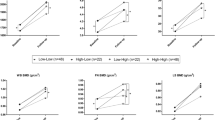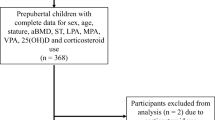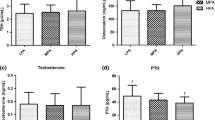Abstract
This longitudinal study examined associations of bone mass with physical activity and vitamin D level over more than 6 years through puberty. A total of 663 participants (320 boys) with mean age 9.6 years at baseline (10–17 years at follow-up), underwent dual energy X-ray absorptiometry, anthropometry and blood samples for vitamin D at least twice during the study period (with three possible time-points). Physical activity was assessed using accelerometers at follow-up. A positive association was found between percent time spent at vigorous physical activity and total-body less head bone mineral content (β = 5.8, p = 0.002). The magnitude of this association increased with maturational development; thus physical activity may have a greater influence on bone mass in the more mature participants. The vitamin D levels were also positively associated with bone mass. A high degree of tracking was observed with changes in anthropometric Z scores predictive of deviation from tracking. No environmental factor predicted deviation from tracking.


Similar content being viewed by others
References
Burge R, Dawson-Hughes B, Solomon DH, Wong JB, King A, Tosteson A (2007) Incidence and economic burden of osteoporosis-related fractures in the United States, 2005–2025. J Bone Miner Res 22(3):465–475. https://doi.org/10.1359/jbmr.061113
Hernandez CJ, Beaupre GS, Carter DR (2003) A theoretical analysis of the relative influences of peak BMD, age-related bone loss and menopause on the development of osteoporosis. Osteoporos Int 14(10):843–847. https://doi.org/10.1007/s00198-003-1454-8
Gomez-Bruton A, Matute-Llorente A, Gonzalez-Aguero A, Casajus JA, Vicente-Rodriguez G (2017) Plyometric exercise and bone health in children and adolescents: a systematic review. World J Pediatr 13(2):112–121. https://doi.org/10.1007/s12519-016-0076-0
Weaver CM, Gordon CM, Janz KF, Kalkwarf HJ, Lappe JM, Lewis R, O’Karma M, Wallace TC, Zemel BS (2016) The National Osteoporosis Foundation’s position statement on peak bone mass development and lifestyle factors: a systematic review and implementation recommendations. Osteoporos Int 27(4):1281–1386. https://doi.org/10.1007/s00198-015-3440-3
Mackelvie KJ, McKay HA, Khan KM, Crocker PR (2001) A school-based exercise intervention augments bone mineral accrual in early pubertal girls. J Pediatr 139(4):501–508. https://doi.org/10.1067/mpd.2001.118190
Meyer U, Romann M, Zahner L, Schindler C, Puder JJ, Kraenzlin M, Rizzoli R, Kriemler S (2011) Effect of a general school-based physical activity intervention on bone mineral content and density: a cluster-randomized controlled trial. Bone 48(4):792–797. https://doi.org/10.1016/j.bone.2010.11.018
Lappe JM, Watson P, Gilsanz V, Hangartner T, Kalkwarf HJ, Oberfield S, Shepherd J, Winer KK, Zemel B (2015) The longitudinal effects of physical activity and dietary calcium on bone mass accrual across stages of pubertal development. J Bone Miner Res 30(1):156–164. https://doi.org/10.1002/jbmr.2319
Janz KF, Letuchy EM, Francis SL, Metcalf KM, Burns TL, Levy SM (2014) Objectively measured physical activity predicts hip and spine bone mineral content in children and adolescents ages 5–15 years: iowa bone development study. Front Endocrinol (Lausanne) 5:112. https://doi.org/10.3389/fendo.2014.00112
Heinonen A, Sievanen H, Kannus P, Oja P, Pasanen M, Vuori I (2000) High-impact exercise and bones of growing girls: a 9-month controlled trial. Osteoporos Int 11(12):1010–1017. https://doi.org/10.1007/s001980070021
Saggese G, Vierucci F, Boot AM, Czech-Kowalska J, Weber G, Camargo CA Jr, Mallet E, Fanos M, Shaw NJ, Holick MF (2015) Vitamin D in childhood and adolescence: an expert position statement. Eur J Pediatr 174(5):565–576. https://doi.org/10.1007/s00431-015-2524-6
Winzenberg T, Powell S, Shaw KA, Jones G (2011) Effects of vitamin D supplementation on bone density in healthy children: systematic review and meta-analysis. BMJ 342:c7254. https://doi.org/10.1136/bmj.c7254
Stein EM, Laing EM, Hall DB, Hausman DB, Kimlin MG, Johnson MA, Modlesky CM, Wilson AR, Lewis RD (2006) Serum 25-hydroxyvitamin D concentrations in girls aged 4–8 y living in the southeastern United States. Am J Clin Nutr 83(1):75–81
Pekkinen M, Viljakainen H, Saarnio E, Lamberg-Allardt C, Makitie O (2012) Vitamin D is a major determinant of bone mineral density at school age. PLoS ONE 7(7):e40090. https://doi.org/10.1371/journal.pone.0040090
Boot AM, Krenning EP, de Muinck Keizer-Schrama SM (2011) The relation between 25-hydroxyvitamin D with peak bone mineral density and body composition in healthy young adults. J Pediatr Endocrinol Metab 24(5–6):355–360
Hazell TJ, Pham TT, Jean-Philippe S, Finch SL, El Hayek J, Vanstone CA, Agellon S, Rodd CJ, Weiler HA (2015) Vitamin D status is associated with bone mineral density and bone mineral content in preschool-aged children. J Clin Densitom 18(1):60–67. https://doi.org/10.1016/j.jocd.2014.04.121
Tonnesen R, Schwarz P, Hovind PH, Jensen LT (2016) Physical exercise associated with improved BMD independently of sex and vitamin D levels in young adults. Eur J Appl Physiol 116(7):1297–1304. https://doi.org/10.1007/s00421-016-3383-1
Cashman KD, Hill TR, Cotter AA, Boreham CA, Dubitzky W, Murray L, Strain J, Flynn A, Robson PJ, Wallace JM, Kiely M (2008) Low vitamin D status adversely affects bone health parameters in adolescents. Am J Clin Nutr 87(4):1039–1044
Joo NS, Dawson-Hughes B, Yeum KJ (2013) 25-Hydroxyvitamin D, calcium intake, and bone mineral content in adolescents and young adults: analysis of the fourth and fifth Korea National Health and Nutrition Examination Survey (KNHANES IV-2, 3, 2008–2009. 2010). J Clin Endocrinol Metab and V-1(9):3627–3636. https://doi.org/10.1210/jc.2013-1480 98 ) .
Valtuena J, Gracia-Marco L, Vicente-Rodriguez G, Gonzalez-Gross M, Huybrechts I, Rey-Lopez JP, Mouratidou T, Sioen I, Mesana MI, Martinez AE, Widhalm K, Moreno LA (2012) Vitamin D status and physical activity interact to improve bone mass in adolescents. The HELENA study. Osteoporos Int 23(8):2227–2237. https://doi.org/10.1007/s00198-011-1884-7
Constantini NW, Dubnov-Raz G, Chodick G, Rozen GS, Giladi A, Ish-Shalom S (2010) Physical activity and bone mineral density in adolescents with vitamin D deficiency. Med Sci Sports Exerc 42(4):646–650. https://doi.org/10.1249/MSS.0b013e3181bb813b
Hauksson HH, Hrafnkelsson H, Magnusson KT, Johannsson E, Sigurdsson EL (2016) Vitamin D status of Icelandic children and its influence on bone accrual. J Bone Miner Metab 34(5):580–586. https://doi.org/10.1007/s00774-015-0704-0
Lehtonen-Veromaa MK, Mottonen TT, Nuotio IO, Irjala KM, Leino AE, Viikari JS (2002) Vitamin D and attainment of peak bone mass among peripubertal Finnish girls: a 3-y prospective study. Am J Clin Nutr 76(6):1446–1453
Foley S, Quinn S, Jones G (2009) Tracking of bone mass from childhood to adolescence and factors that predict deviation from tracking. Bone 44(5):752–757. https://doi.org/10.1016/j.bone.2008.11.009
Nilsen OA, Ahmed LA, Winther A, Christoffersen T, Furberg AS, Grimnes G, Dennison E, Emaus N (2017) Changes and tracking of bone mineral density in late adolescence: the Tromso Study, Fit Futures. Arch Osteoporos 12(1):37. https://doi.org/10.1007/s11657-017-0328-1
Kalkwarf HJ, Gilsanz V, Lappe JM, Oberfield S, Shepherd JA, Hangartner TN, Huang X, Frederick MM, Winer KK, Zemel BS (2010) Tracking of bone mass and density during childhood and adolescence. J Clin Endocrinol Metab 95(4):1690–1698. https://doi.org/10.1210/jc.2009-2319
Wedderkopp N, Jespersen E, Franz C, Klakk H, Heidemann M, Christiansen C, Moller NC, Leboeuf-Yde C (2012) Study protocol. The Childhood Health, Activity, and Motor Performance School Study Denmark (The CHAMPS-study DK). BMC Pediatr 12:128. https://doi.org/10.1186/1471-2431-12-128
Heidemann M, Jespersen E, Holst R, Schou AJ, Husby S, Molgaard C, Wedderkopp N (2013) The impact on children’s bone health of a school-based physical education program and participation in leisure time sports: the Childhood Health, Activity and Motor Performance School (the CHAMPS) study, Denmark. Prev Med 57(2):87–91. https://doi.org/10.1016/j.ypmed.2013.04.015
Moore SA, McKay HA, Macdonald H, Nettlefold L, Baxter-Jones AD, Cameron N, Brasher PM (2015) Enhancing a somatic maturity prediction model. Med Sci Sports Exerc 47(8):1755–1764. https://doi.org/10.1249/mss.0000000000000588
Moller NC, Tarp J, Kamelarczyk EF, Brond JC, Klakk H, Wedderkopp N (2014) Do extra compulsory physical education lessons mean more physically active children—findings from the childhood health, activity, and motor performance school study Denmark (The CHAMPS-study DK). Int J Behav Nutr Phys Act 11:121. https://doi.org/10.1186/s12966-014-0121-0
Heidemann M, Molgaard C, Husby S, Schou AJ, Klakk H, Moller NC, Holst R, Wedderkopp N (2013) The intensity of physical activity influences bone mineral accrual in childhood: the childhood health, activity and motor performance school (the CHAMPS) study, Denmark. BMC Pediatr 13:32. https://doi.org/10.1186/1471-2431-13-32
Trost SG, Loprinzi PD, Moore R, Pfeiffer KA (2011) Comparison of accelerometer cut points for predicting activity intensity in youth. Med Sci Sports Exerc 43(7):1360–1368. https://doi.org/10.1249/MSS.0b013e318206476e
Munns CF, Shaw N, Kiely M, Specker BL, Thacher TD, Ozono K, Michigami T, Tiosano D, Mughal MZ, Makitie O, Ramos-Abad L, Ward L, DiMeglio LA, Atapattu N, Cassinelli H, Braegger C, Pettifor JM, Seth A, Idris HW, Bhatia V, Fu J, Goldberg G, Savendahl L, Khadgawat R, Pludowski P, Maddock J, Hypponen E, Oduwole A, Frew E, Aguiar M, Tulchinsky T, Butler G, Hogler W (2016) Global consensus recommendations on prevention and management of nutritional rickets. Horm Res Paediatr 85(2):83–106. https://doi.org/10.1159/000443136
Pearson N, Haycraft E, J PJ, Atkin AJ (2017) Sedentary behaviour across the primary-secondary school transition: a systematic review. Prev Med 94:40–47. https://doi.org/10.1016/j.ypmed.2016.11.010
McCormack SE, Cousminer DL, Chesi A, Mitchell JA, Roy SM, Kalkwarf HJ, Lappe JM, Gilsanz V, Oberfield SE, Shepherd JA, Winer KK, Kelly A, Grant SFA, Zemel BS (2017) Association between linear growth and bone accrual in a diverse cohort of children and adolescents. JAMA Pediatr. https://doi.org/10.1001/jamapediatrics.2017.1769
Bailey DA, McKay HA, Mirwald RL, Crocker PR, Faulkner RA (1999) A six-year longitudinal study of the relationship of physical activity to bone mineral accrual in growing children: the university of Saskatchewan bone mineral accrual study. J Bone Miner Res 14(10):1672–1679. https://doi.org/10.1359/jbmr.1999.14.10.1672
Gabel L, Macdonald HM, Nettlefold L, McKay HA (2017) Physical activity, sedentary time, and bone strength from childhood to early adulthood: a mixed longitudinal HR-pQCT study. J Bone Miner Res 32(7):1525–1536. https://doi.org/10.1002/jbmr.3115
Farrar MD, Mughal MZ, Adams JE, Wilkinson J, Berry JL, Edwards L, Kift R, Marjanovic E, Vail A, Webb AR, Rhodes LE (2016) Sun exposure behavior, seasonal vitamin D deficiency, and relationship to bone health in adolescents. J Clin Endocrinol Metab 101(8):3105–3113. https://doi.org/10.1210/jc.2016-1559
Yang Y, Wu F, Winzenberg T, Jones G (2017) Tracking of areal bone mineral density from age eight to young adulthood and factors associated with deviation from tracking: a 17-yr prospective cohort study. J Bone Miner Res. https://doi.org/10.1002/jbmr.3361
Baxter-Jones AD, Kontulainen SA, Faulkner RA, Bailey DA (2008) A longitudinal study of the relationship of physical activity to bone mineral accrual from adolescence to young adulthood. Bone 43(6):1101–1107. https://doi.org/10.1016/j.bone.2008.07.245
Warren JM, Ekelund U, Besson H, Mezzani A, Geladas N, Vanhees L (2010) Assessment of physical activity - a review of methodologies with reference to epidemiological research: a report of the exercise physiology section of the European Association of Cardiovascular Prevention and Rehabilitation. Eur J Cardiovasc Prev Rehabil 17(2):127–139. https://doi.org/10.1097/HJR.0b013e32832ed875
Janz KF, Medema-Johnson HC, Letuchy EM, Burns TL, Gilmore JM, Torner JC, Willing M, Levy SM (2008) Subjective and objective measures of physical activity in relationship to bone mineral content during late childhood: the Iowa Bone Development Study. Br J Sports Med 42(8):658–663. https://doi.org/10.1136/bjsm.2008.047779
Acknowledgements
We thank participants and schools for their participation in the Childhood Health Activity and Motor Performance School study. We gratefully acknowledge the team behind the CHAMPS-study DK consisting of numerous researchers and students participating in data collection and Mette Vogn Hviid for her contribution with the numerous DXA-scans as operator during the whole study period.
Funding
The study was supported by the Danish foundation “Tryg-fonden”, the Region of Southern Denmark, Hospital of Southern Jutland and “Kirsten og Freddy Johansens Fond”.
Author information
Authors and Affiliations
Contributions
MSR, MH, AS, JOL, SH, NW and CM designed the research and interpreted the data. MSR, MH and JT contributed to collecting data and LL and NRJ contributed to laboratory analyses. MSR and NW analysed the data and MSR prepared the first draft of the paper. All authors revised the paper critically and approved the final version. All authors agree to be accountable for the work and to ensure that any questions relating to the accuracy and integrity of the paper are investigated and properly resolved.
Corresponding author
Ethics declarations
Conflict of interest
Dr. Rønne reports grants and personal fees from The Danish foundation “Tryg-fonden”, personal fees from The Region of Southern Denmark, personal fees from Hospital of Southern Jutland, other from Kirsten og Freddy Johansens Fond, during the conduct of the study. Dr. Lylloff and Dr Jørgensen report grants from Kirsten and Freddy Johansens Foundation, during the conduct of the study. Dr. Heidemann, Dr Schou, Dr Tarp, Dr. Laursen, Dr. Husby, Dr. Wedderkopp, and Dr. Mølgaard have nothing to disclose.
Human Rights and Informed Consent
Children and parents received written information about the study together with verbal information at school meetings. Parents provided written informed consent before enrolment in the study. For all children participation was voluntary and consent could be withdrawn at any time. The CHAMPS-study DK was approved by the Regional Scientific Ethical Committee of Southern Denmark (Project ID: S2008-0047, S-20140105).
Rights and permissions
About this article
Cite this article
Rønne, M.S., Heidemann, M., Lylloff, L. et al. Bone Mass Development in Childhood and Its Association with Physical Activity and Vitamin D Levels. The CHAMPS-Study DK. Calcif Tissue Int 104, 1–13 (2019). https://doi.org/10.1007/s00223-018-0466-5
Received:
Accepted:
Published:
Issue Date:
DOI: https://doi.org/10.1007/s00223-018-0466-5




